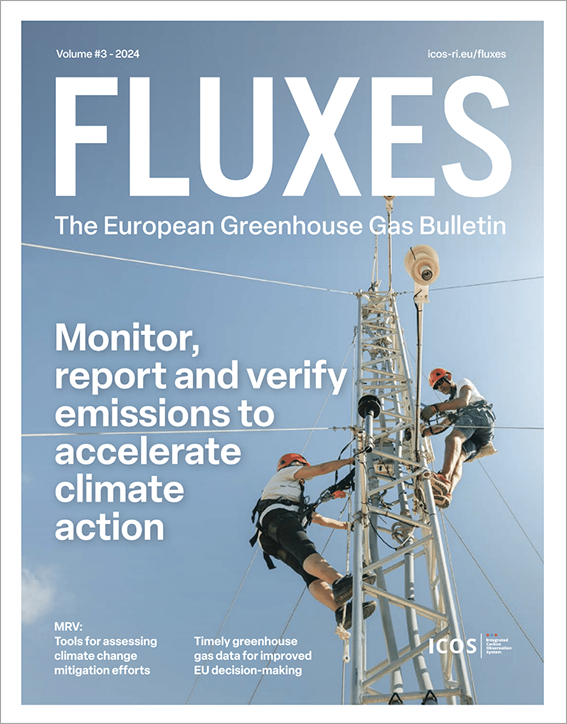
We need to drastically reduce our greenhouse gas emissions to avoid the worst impacts of climate change. The latest issue of FLUXES, The European Greenhouse Gas Bulletin by ICOS, sheds light on an essential tool to help decision-makers assess progress towards a net zero world: science-based Monitoring, Reporting and Verification (MRV) systems.
Monitoring refers to data and information regarding emissions. Reporting is the act of compiling this information into inventories. Verification points to independent assessment of the reported information to ensure accuracy. MRV is already well established in the UNFCCC framework with the national inventories. However, complementing the inventories with MRV systems, informed by scientifically measured greenhouse gas data, increases the power to support societies in their climate action from the local to the global scale:
- Help improve emission inventories for cities, countries or regions like the EU
- Support policymaking by providing actual measured data to track emission reduction pathways
- Integrate local, national and regional efforts into a global monitoring of our way to net-zero.
MRV helps improve emission inventories
National greenhouse gas emission inventories are the main way countries estimate their emissions for the UNFCCC Global Stocktake. The inventories are based on statistical data that focus mostly on human impact – for example the amount of produced steel, animals in the agricultural sector or the amount of coal burned in power plants. In comparison, scientific MRV systems use direct greenhouse gas observations, such as those provided by ICOS, that can help reduce the uncertainties of inventories.
“If we want to understand what is going on in the atmosphere, we need information on both human emissions and natural fluxes. Even though there is some uncertainty in the fossil fuel emission inventories, the bigger uncertainty is in the natural fluxes,” says ICOS Director General Werner Kutsch.
Several countries, including Switzerland and the United Kingdom, are already complementing their greenhouse gas inventories with direct measurements feeding into a national MRV system. The ICOS network of nearly 180 observation stations, spread across Europe, provides near-real-time open access greenhouse gas data that can be used for such system.
MRV tracks emission reduction targets
The EU has ambitious emission reductions targets for 2040. A recent proposal by the European Commission aims to cut the region’s net emissions by 90% compared to 1990 levels.
“These targets cannot be achieved without effective ‘follow-up’ actions. MRV systems offer critical tools for assessing climate action and empowering countries to improve their greenhouse gas emission mitigation efforts,” says Werner Kutsch.
On top of the emission reduction, the new EU legislation aims to increase carbon removals and storage especially in the land use sector. These laws need to be underpinned by scientifically robust methodologies as part of an MRV system.
“MRV systems are key to understanding what is happening on the ground, providing a picture of the condition of for example soil and biomass across the EU. Policymakers can also use MRV to understand the implications of policies affecting farmers and foresters when land is converted away from agricultural production, in addition to giving insight to the drivers of biodiversity loss and how to best use incentives to drive change,” say Simon Kay, Deputy Head of Unit, DG CLIMA, European Commission, and John van Aardenne, Head of Group, European Environment Agency, in an opinion piece in FLUXES.
MRV transforms climate change mitigation accountability
A global effort is under way that will provide near-real-time greenhouse gas data covering all continents of the world - at a 100 x 100 km scale. Launching in 2028, the Global Greenhouse Gas Watch (G3W) initiative brings together a global network of satellite operators, surface-based observation systems like ICOS and modelling expertise to gather the best existing knowledge and technology.
“The G3W will give us a tool to inform and guide climate action as well as evaluate the efficacy of the Nationally Determined Contributions (NDCs). We need to invest substantially to permit every country to engage in surface-based observations, quality control and assessment, verification and reporting,” says Gianpaolo Balsamo, G3W Director, World Meteorological Organization (WMO).
In Europe, Copernicus and ICOS are providing the blueprints for the monitoring system, that has the capacity to extend high-level monitoring, reporting and verification capacities to the whole continent.
FLUXES is an annual publication by ICOS, the Integrated Carbon Observation System – a European Research Infrastructure. The aim is to highlight topical climate issues to policy advisers and climate journalists. The first volume was published in 2022.